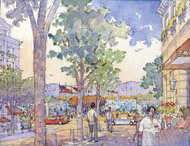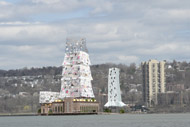|
FEATURE ARTICLE, MAY 2007
REBUILD TO REVITALIZE
Yonkers, New York, undertakes efforts to redevelop its commercial industry.
Dan Marcec
 |
The master plan for the revitalization of Yonkers, New York, will encompass 500 acres of land and will include a large retail component, residential towers, a minor league baseball stadium and office space.
|
|
The city of Yonkers, New York, which borders the New York City borough of The Bronx, currently is seeing an unprecedented revitalization effort in order to bring more business and economic prosperity to the city, in addition to improving the overall quality of life for its residents.
“Obviously, the development occurring in Yonkers will provide jobs — construction jobs, temp jobs and permanent jobs. The tax base will increase dramatically, and it builds enormous value within the city,” says Ellen Lynch, president and chief executive officer of the Yonkers Industrial Development Agency. “I have been in commercial real estate for 20 years, and the development here in Yonkers is intriguing.”
Lynch is referring to the fact that she recently began work with the Yonkers IDA this past June, and as president and CEO of the agency, she is responsible for fostering the multiplicity of commercial real estate development across town. As a whole, the agency works in conjunction with the city’s Office of Economic Development and with real estate businesses interested in working in Yonkers to ensure that the proposed developments will be a good match for the city. Overall, though, the main key to the revitalization boom in Yonkers has been local, state and federal support.
“One of the key components to making all this activity real is the fact that the city’s administration has developed great working relationships with the state and the federal agencies. This has changed their attitudes toward development in our city. Players at all levels of government are stepping up and saying ‘we see things happening, in Yonkers and we want to help’,” says Lynch. “The State of New York came through with a grant to ‘daylight’ a significant underground stretch of the Saw Mill River, and with an additional grant from the Port Authority of New York and New Jersey, we will be able to revitalize the historic Yonkers pier and bring a ferry from Battery Park City in Manhattan straight to downtown. When you have such a dramatic amount of redevelopment going on, you really do need support from all levels. This seems to be happening, and there is a lot of positive energy.”
As Lynch mentions, the local administration has been instrumental to Yonkers’ revitalization efforts. Mayor Phil Amicone, who took this position in January 2004, served as deputy mayor of the city for 8 years prior, with his background in economic development coming in handy. In his former position, he dealt closely with many developers, and now as the mayor, he knows it is important for investors to understand that the government is behind their efforts.
“I need the investors in Yonkers to understand that revitalization of the city is important enough for the mayor to be involved,” says Amicone. “We’re changing the way the city is perceived, and we want to create a job market so our children can have a place to stay, instead of having to leave in order to find jobs elsewhere. The downtown area was the center of business for so many years, and we intend to make it that way again.”
Numerous developments are taking place in accordance with the city’s efforts to revitalize its real estate, beginning first and foremost with the city’s Master Plan, which involves redeveloping the downtown district. Streuver Brothers, Fidelco Group and Louis Capelli are primarily responsible for the project’s development, with the first two companies being involved for the past few years compiling plans. Capelli is a local developer that has done a lot of work in Westchester County, and all three joined up last year on the new master agreement, which really expanded the size and the scope of the project.
In total, the Master Plan will encompass a staggering 500 acres of land, and a general estimate of the project cost is $3.1 billion. The development is broken down into phases, with the finer points of Phase I’s plans currently being finalized. The first phase includes the redevelopment the Chicken Island site near City Hall — to be renamed River Park Center — that includes a large retail component, two residential towers called Palisades Point, and a 6,500-seat minor league baseball stadium to be constructed on top of this retail project. Winding through River Park Center is the Saw Mill River, which is being daylighted and landscaped to create a pedestrian-friendly environment through Larkin Square opposite the train station. The breakdown of River Park Point includes approximately 175,000 square feet of office space, 800 residential units, a hotel, and 100,000 square feet of retail space. Retail space along the riverfront will include more local tenants, with national and local tenants mixed in elsewhere. In Phase II, the project will move on through the rest of Alexander Street, eventually completing the whole extension of the Nepperhan Valley. Collins II is another residential project on the waterfront, and in conjunction with that groundbreaking, there is a bridge being constructed on a walking esplanade onto the river.
“The Master Plan project is accessible to everyone in the city, creating a destination for the people of Yonkers, where they can come and enjoy the natural environment of the downtown,” says Lynch. “The other thing that works well in conjunction with this project is the Metro North and Amtrak railroad line. There are three stops on this stretch of waterfront, and the main station is right at the core of all this — the station was redone a few years ago, designed by the architects who did Grand Central Terminal in New York City. Overall, including the ferry from the pier, the plan creates a transportation center where people can come in and out of the city, and wherever they need to go, they can get there readily.”
One of the other major projects going on in Yonkers is the Ridge Hill Village development, which is an $800 million project ready to get underway. With a combination of retail space and residential units it should become a place to be in a completely different part of the city on the east side of town. Situated on 81 acres, the project encompasses 1.3 million square feet of retail space and will have 1,000 residential units. The project includes approximately 200,000 square feet of office space and a hotel as well. Ridge Hill is breaking ground in 2007 with completion expected in 2009.
Finally, support to revitalize Ashburton Avenue from the federal government will help facilitate many aspects of the development in Yonkers. Ashburton Avenue serves as a connector to the downtown for people accessing the city from the Saw Mill River Parkway, the Henry Hudson Parkway and the New York State Thruway (interstates 87 and 287). Lynch says, “It needs many improvements to accommodate the increase in activity we expect coming into the city — particularly to the waterfront. Roadway and sidewalks will be widened, and, in some locations, straightened. We will address traffic signaling and street lighting along the road to make it more workable for residents and visitors to the city.”
In total, the plan to revitalize Yonkers will have a significant impact on the local economy, and on all aspects of life in the city. Mayor Amicone concludes, “With an extensive urban revitalization program; over $1 billion invested in the last 5 years and anywhere from $5 billion and up being invested in the next 5 years; significant mixed-use and residential development; and adding thousands of jobs and many millions of dollars to the tax base; we’re developing momentum and keeping it going, which is a huge plus for any economy to retain its strength.”
REMI Development Adds to the Revitalization of Yonkers
 |
Better at Glenwood will be a 25-story residential tower on the site of the former Glenwood Power Station in Yonkers, New York.
|
|
REMI Development is currently developing two new projects in the city of Yonkers, New York. The first, Velocity at Greystone, is a 79-unit luxury apartment building that will contain nine studios, 54 one-bedroom units, 13 two-bedroom units and three three-bedroom units. In addition, the nine-story building will feature a 112-space underground parking garage. The development is made possible by financial assistance provided to the developer through the Yonkers Industrial Development Agency. The second development, BETTER at Glenwood, is a mixed-use project on the site of the former Glenwood Power Station. The centerpiece of the project includes a 25-story residential tower designed by the architect Alsop. The residential tower will be New York’s first carbon-free building. In addition, REMI development will be preserving a great portion of the Glenwood Power Station in its development. The mixed-use development will also include a contemporary art museum, a landscaped promenade along the Hudson River, recreation parks and fields, plus a variety of waterfront restaurants and shops.
— Stephanie Mayhew |
©2007 France Publications, Inc. Duplication
or reproduction of this article not permitted without authorization
from France Publications, Inc. For information on reprints
of this article contact Barbara
Sherer at (630) 554-6054.
|
